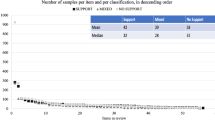Abstract
It is commonly assumed that the English interrogative/relative pronounwhom is parallel to him and them in manifesting objective pronominal Case. We argue instead that whom is not Case-marked along with these pronouns. Rather, its Case marking follows a different paradigm. Whom in modern English derives from a set of extra-grammatical rules called 'grammatical viruses'. Speakers call upon such rules to check Case and (possibly) agreement features which the normal system of syntax cannot check, but which prestige usage demands. Sentences with whom are typical of sentences resulting from grammatical viruses. Such virus-licensed products have a 'prestige' status, they are not typical of child language, and theintuitions about their use are strikingly different from intuitions about the use of other grammatical elements that they are traditionally claimed to work along the lines of. In the latter instance, intuitions about the use of whom differ markedly from intuitions about the use of ACC personal pronouns.
A common rule for determining whether “who” or “whom” isright is to substitute “she” for “who”, and “her” for “whom”,and see which sounds the better. Take the sentence, “He met awoman who they said was an actress”. Now if “who” is correctthen “she” can be used in its place. Let us try it. “He met a womanshe they said was an actress”. That instantly rings false. It can't beright. Hence the proper usage is “whom”.
In certain cases grammatical correctness must often be subordinated to aconsideration of taste. For instance, suppose that same person had met aman whom they said was a street cleaner. The word “whom” is too austereto use in connection with a lowly worker, like a street cleaner, and its use is known as False Admiration or Pathetic Fallacy. Thurber (1931, p. 101) discussed.
Similar content being viewed by others
REFERENCES
Chomsky, Noam: 1993, 'A Minimalist Program for Linguistic Theory', in K. Hale and S. J. Keyser (eds.), The View from Building 20, MIT Press, Cambridge, Massachusetts, pp. 1–52.
Chomsky, Noam: 1995, The Minimalist Program, MIT Press, Cambridge, Massachusetts.
Duncan-Jones, Katherine: 1999, 'Why, then, O brawling love!' The Times Literary Supplement No 5001, February 5, 18.
Emonds, Joseph E: 1970, Root and Structure-Preserving Transformations, Ph.D. dissertation, MIT.
Emonds, Joseph E: 1986, 'Grammatically Deviant Prestige Constructions', in M. Brame, H. Contrares and F. Newmeyer (eds.), Festschrift for Sol Saporta, Noit Amrofer, Seattle, pp. 93-129.
Follett, Wilson: 1966, Modern American Usage: A Guide, Hill and Wang, New York.
Fowler, H. W.: 1965, A Dictionary of Modern English Usage, 2nd ed., Oxford Univ. Press, New York and Oxford.
Heycock, Caroline: 1994, 'The Internal Structure of Small Clauses: New Evidence from Inversion', in J. N. Beckman (ed.), Proceedings of NELS 25, Vol. 1, GLSA, University of Massachusetts, Amherst, pp. 223-238.
Jespersen, Otto: 1965 [1924], The Philosophy of Grammar, Norton, New York.
Jespersen, Otto: 1970 [1909-1949], A Modern English Grammar on Historical Principles, vol. 5, George Allen and Unwin, London.
Kayne, Richard S.: 1984, Connectedness and Binary Branching, Foris, Dordrecht.
Klima, Edward S.: 1964, 'Relatedness Between Grammatical Systems', Language 40, 1-20.
McCawley, James A.: 1988, The Syntactic Phenomena of English (2 vols.), University of Chicago Press, Chicago.
Morgan, Jerry L.: 1972, 'Verb Agreement as a Rule of English', CLS 8, 278-286.
Olson, Gary A., and Lester Faigley: 1991, 'Language, Politics and Composition: A Conversation with Noam Chomsky', Journal of Advanced Composition 11, 1-35.
Oxford English Dictionary (2nd ed.) on CD: 1992, Oxford University Press, London.
Quattlebaum, Judith A.: 1994, 'A Study of Case Assignment in Coordinate Noun Phrases', Language Quarterly 32, 131-147.
Rouveret, Alain and J.-R. Vergnaud: 1980, 'Specifying Reference to the Subject', Linguistic Inquiry 11, 97-202.
Sobin, Nicholas: 1997, 'Agreement, Default Rules, and Grammatical Viruses', Linguistic Inquiry 28, 318-343.
Thurber, James: 1931, The Owl in the Attic and Other Perplexities, Part Three: Ladies' and Gentlemen's Guide to Modern English Usage, Grosset and Dunlop, New York.
Traugott, Elizabeth C.: 1972, The History of English Syntax, Holt, Rinehart and Winston, New York.
Whitford, Robert C. and James R. Foster: 1937, American Standards of Writing, with a Comprehensive Handbook of Current Usage, Farrar and Rinehart, New York.
Author information
Authors and Affiliations
Rights and permissions
About this article
Cite this article
Lasnik, H., Sobin, N. The Who/Whom Puzzle: On The Preservation Of An Archaic Feature. Natural Language & Linguistic Theory 18, 343–371 (2000). https://doi.org/10.1023/A:1006322600501
Issue Date:
DOI: https://doi.org/10.1023/A:1006322600501



